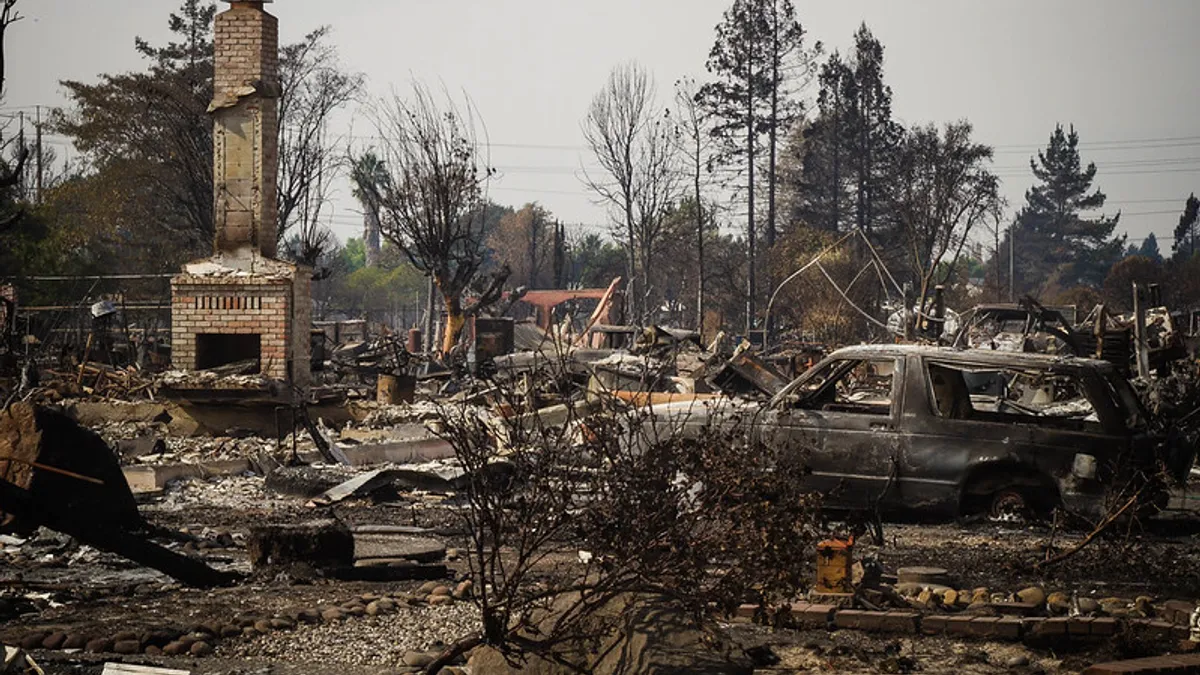Dive Brief:
- Pacific Gas & Electric (PG&E) could face a loss of more than $600 million related to the Kincade Fire, which occurred in Northern California's Sonoma region after the utility had filed for Chapter 11 bankruptcy, it announced in its quarterly filing with the U.S. Securities and Exchange Commission Friday.
- The utility also filed an application with the California Public Utilities Commission (CPUC) on Thursday, requesting authority to finance $7.5 billion of the claims from the 2017 North Bay wildfires through recovery bonds, under the agency's "stress test" process.
- PG&E expects to have its reorganization plan confirmed by the bankruptcy court June 30 — a legislative deadline it must meet to access California's new wildfire insurance fund — and currently plans to emerge from bankruptcy by Aug. 29, it said in the application.
Dive Insight:
The Kincade Fire began in October 2019 and burned more than 77,000 acres in Northern California, without causing any fatalities. It coincided with a public safety power shut-off that PG&E deployed to the region, which affected nearly 28,000 customers. While PG&E shut off its distribution lines, its transmission lines remained energized.
State investigators and the utility itself are still investigating the cause of the fire, but PG&E believes its "reasonably possible" that it will incur a loss exceeding $600 million — the lower end of their range — "based on the facts and circumstances," it announced in its 10-Q.
PG&E Corp. also announced its first-quarter earnings on Friday, which included a $371 million income available for common shareholders, or $0.57 per share, compared to $136 million for the first quarter of 2019.
The company is currently in the midst of planning its exit from Chapter 11 bankruptcy, which it filed for early last year due to billions of dollars in liabilities from previous fires that occurred in its service territory. It recently announced that PG&E Corp. President and CEO Bill Johnson intends to leave the company after its bankruptcy plan is confirmed, and will be replaced on a temporary basis by board member William Smith.
Johnson is "quite proud" of what PG&E and its employees have achieved in the past year, he said in a press release.
PG&E also detailed its progress to date on completing wildfire mitigation work in its service territory, including trimming away vegetation that is close to its power lines and upgrading infrastructure in certain areas. It anticipates $1.3 billion in expenses and $1.4 billion in capital expenditures on fire mitigation work this year, and is deploying a combination of temporary generation, speedier restoration and more precise modeling to reduce the impact of the safety-related power shut-offs it deploys during high fire-risk conditions.
If the weather patterns from 2019 repeat, "our mitigation efforts should reduce the number of customers impacted by those PSPS events by approximately one-third," PG&E said in its earnings presentation.
Securitization plan will expedite fire victim payments, PG&E says
Separately, the utility has approached regulators for permission to finance $7.5 billion of claims costs from the 2017 North Bay wildfires by issuing recovery bonds. This would allow PG&E to retire $6 billion in temporary debt and expedite payments to fire victims, PG&E said.
PG&E is asking for this treatment as part of the CPUC's "stress-test" methodology — a mechanism that was adopted by state legislators in 2018.
The test essentially requires the CPUC to take into consideration a utility's financial status when deciding the amount of fire-related costs it should bear. Any costs that exceed that amount could be recovered through bonds — "and ratepayers end up paying for the bonds, so that ends up being a ratepayer hit," April Rose Maurath Sommer, executive and legal director of the Wild Tree Foundation, told Utility Dive.
PG&E said in its application that the proposal is in alignment with California Gov. Gavin Newsom's statements on its bankruptcy plan, and is designed to be "rate-neutral and customer-protective." The utility plans to provide its customers with shareholder-funded credits, setting up a trust with a $1.8 billion initial contribution and up to $7.59 billion in additional contributions.
The utility asked the commission not to commit a review of the "reasonableness" of the costs, noting that "PG&E does not contend that the claims costs at issue are just and reasonable."
But that's the whole problem with the stress test, Maurath Sommer said — it was created as a one-time fix for utilities regardless of whether the financial costs involved were determined to be "reasonable" for recovery.
"The stress test was created by the legislature in SB 901, I think in an attempt to basically prevent the utilities from going into bankruptcy, and PG&E made the elective and fully voluntary choice to file for bankruptcy, undermining the entire purpose of this ratepayer funded bailout," she said.
"If it ends up being applied to PG&E, it's going to be another huge hit to ratepayers," added Maurath Sommer.
The securitization proposal is designed to ensure a safe and financially-sound PG&E moving forward, will be rate-neutral to customers, and has been authorized by the Legislature in SB 901 and endorsed by Newsom's office, PG&E spokesperson James Noonan said in an emailed statement.
"Under the expected outcome of this proposal, PG&E shareholders are ultimately paying for 100 percent of wildfire claims. PG&E expects customers will experience no net increase in their bills over the life of the bonds, and has proposed to share 25 percent of any surplus balance in the Customer Credit Trust," he added.














